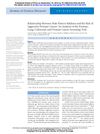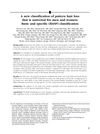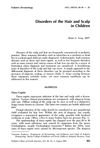TLDR The M-type is the most common form of male hair loss, and the BASP-classification is easy for different medical professionals to use.
The study examined the application of the BASP-classification for androgenetic alopecia (AGA) in 212 men aged 18 and older, excluding those with certain conditions. The average age was 47.9 years. The M-type, either alone or combined with other types, was the most common, observed in 75% of patients. AGA was classified by severity, with 33.4% having mild, 48.5% moderate, and 53.3% severe AGA. Early onset before age 30 was noted in 10.3% of patients. The study concluded that the M-type was the most frequent, but more observations are needed to determine the prevalence of AGA types in the Belarusian population. The BASP-classification's simplicity allows for use by various medical professionals, promoting interdisciplinary collaboration in studying AGA as a cosmetic issue or disease indicator.
1 citations
,
September 2018 in “Vestnik Vitebskogo gosudarstvennogo medicinskogo universiteta”  47 citations
,
June 2016 in “JAMA Dermatology”
47 citations
,
June 2016 in “JAMA Dermatology” Men with early hair loss have similar hormone levels to women with PCOS, possibly increasing risk of obesity and heart issues.
 101 citations
,
January 2016 in “Journal of Cutaneous and Aesthetic Surgery”
101 citations
,
January 2016 in “Journal of Cutaneous and Aesthetic Surgery” Different types of hair loss need specific treatments, and while many classification systems exist, each has its flaws; more research is needed to refine these systems and treatments.
 28 citations
,
September 2014 in “Journal of Clinical Oncology”
28 citations
,
September 2014 in “Journal of Clinical Oncology” Men with baldness at the front and top of their head at age 45 may have a higher risk of aggressive prostate cancer.
 125 citations
,
May 2007 in “Journal of The American Academy of Dermatology”
125 citations
,
May 2007 in “Journal of The American Academy of Dermatology” The BASP classification is a detailed and accurate way to categorize hair loss in both men and women.
1 citations
,
January 2000 in “Indian Journal of Dermatology” A woman had hair loss and scalp nodules due to black piedra, confirmed by tests.
 6 citations
,
August 1991 in “Pediatric Clinics of North America”
6 citations
,
August 1991 in “Pediatric Clinics of North America” The document concludes that various hair and scalp disorders in children have specific treatments and proper diagnosis is essential.
 2 citations
,
May 1974 in “PubMed”
2 citations
,
May 1974 in “PubMed” The article described symptoms and treatments for four common hair problems but didn't give detailed information.






